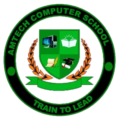Training Overview
AMTECH Computer Training School, located in Koforidua, Ghana, specializes in digital computer literacy for students entering secondary education. Founded to empower learners, the school focuses on equipping students with essential digital skills through a structured curriculum. Students engage with interactive modules that include quizzes, exercises, and simulations, making learning both effective and enjoyable. AMTECH stands out for its commitment to catering to diverse learning styles with visuals and hands-on activities, fostering an engaging environment that prepares students for success in an increasingly technology-driven world.
Module 1: Computers Basics
1.1 History of Computers
1.2 Computer Components
1.3 Types of Computers (Desktop and Laptop)
1.4 Computer Applications
Module 2: Operating Systems
2.1 Introduction to Operating Systems
2.2 Windows Operating System
2.3 macOS Operating System
2.4 Linux Operating System
2.5 Mobile Operating Systems
Module 3: PC Hardware
3.1 Computer Hardware Components
3.2 CPU (Central Processing Unit)
3.3 Memory (RAM)
3.4 Storage Devices (HDD, SSD)
3.5 Input/Output Devices
Module 4: Software Applications
4.1 Microsoft Office Suite
4.2 Google Suite
4.3 Adobe Photoshop Design
4.4 Social Zoom Platforms
4.5 Email and Online Communication
Module 5: Networking
5.1 Introduction to Networking
5.2 Types of Networks (LAN, WAN, Wi-Fi)
5.3 Internet Basics
5.4 Online Safety and Security
5.5 Email and Online Communication
Module 6: Cyber Security
6.1 Introduction to Cybersecurity
6.2 Types of Cyber Threats
6.3 Password Management
6.4 Online Safety Best Practices
6.5 Data Backup and Recovery
Module 7: Cyber Citizenship
7.1 Digital Etiquette
7.2 Online Communication
7.3 Cyberbullying Prevention
7.4 Digital Footprint Management
7.5 Ai Resources and Tools
Module 8: PC Maintenance
8.1 Computer Maintenance Basics
8.2 Virus Removal
8.3 Disk Cleanup and Defragmentation
8.4 Software Updates
8.5 Backup and Recovery
Module 9: Advanced Topics
9.1 Network Security
9.2 Ai Cyber Security
9.3 Computer Forensics
9.4 Promt Engineering
9.5 Computer Security
Module 10: Project
10.1 Create a Personal Website
10.2 Develop a Digital Portfolio
10.3 Design a Database
10.4 Create a Presentation
10.5 Final Project Presentation
DIGITAL LITERACY
Digital literacy refers to the ability to effectively use digital technology, including computers and the internet, to navigate, evaluate, and communicate information. It encompasses a range of skills, such as Technical Skills, Critical Thinking and Content Creation.
PRO-COURSES: 8 WEEKS+
Basic Computer Skills
- Computer hardware: Understanding computer hardware components, such as CPU, memory, and storage devices.
- Operating System: Familiarity with operating systems, such as Windows, macOS, or Linux.
- Software applications: Proficiency in using software applications, such as Microsoft Office, Google Suite, or other productivity tools.
Internet and Online Skills
- Internet navigation: Ability to navigate the internet, including searching, browsing, and accessing online resources.
- Email and communication: Understanding email etiquette, composing and sending emails, and using online communication tools.
- Online safety and security: Knowledge of online safety and security measures, including password management, phishing, and malware protection.
Digital Literacy Skills
- Digital citizenship: Understanding digital citizenship, online etiquette, and responsible digital behavior.
- Critical thinking: Ability to think critically and evaluate online information.
- Media literacy: Understanding different types of digital media, including text, images, audio, and video.
Productivity and Collaboration Tools
- Microsoft Office: Proficiency in using Microsoft Office applications, such as Word, Excel, and PowerPoint.
- Google Suite: Familiarity with Google Suite applications, such as Google Docs, Sheets, and Slides.
- Collaboration tools: Understanding collaboration tools, such as Zoom, Slack, or Microsoft Teams.
Data Analysis and Interpretation
- Data management: Ability to manage and organize data, including creating and editing spreadsheets.
- Data analysis: Understanding basic data analysis concepts, including charts, graphs, and statistical analysis.
- Data interpretation: Ability to interpret and draw conclusions from data.
Troubleshooting and Problem-Solving
- Troubleshooting: Basic troubleshooting skills, including identifying and resolving common computer issues.
- Problem-solving: Ability to solve problems using computer applications and online resources.
- Critical thinking: Ability to think critically and develop innovative solutions.
